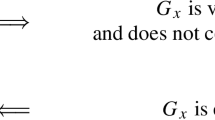Abstract
Complex-balanced mass-action systems are some of the most important types of mathematical models of reaction networks, due to their widespread use in applications, as well as their remarkable stability properties. We study the set of positive parameter values (i.e., reaction rate constants) of a reaction network G that, according to mass-action kinetics, generate dynamical systems that can be realized as complex-balanced systems, possibly by using a different graph \(G'\). This set of parameter values is called the disguised toric locus of G. The \({\mathbb {R}}\)-disguised toric locus of G is defined analogously, except that the parameter values are allowed to take on any real values. We prove that the disguised toric locus of G is path-connected, and the \({\mathbb {R}}\)-disguised toric locus of G is also path-connected. We also show that the closure of the disguised toric locus of a reaction network contains the union of the disguised toric loci of all its subnetworks.


Similar content being viewed by others
Data Availability
Data sharing not applicable to this article as no datasets were generated or analyzed during the current study.
Notes
Note that when \(\varvec{y}_0 \not \in V\) or \(\varvec{y}_0 \not \in \tilde{V}\), that side is considered as an empty sum, which is zero.
For simplicity, in the rest of this paper, we abuse the following notation: Given \(\varvec{k}\in {\mathbb {R}}_{>0}^{E}\), we will refer to the mass-action system generated by G and \(\varvec{k}\) as in Eq. (2) as “the mass-action system \((G, \varvec{k})\)”. Moreover, we will still refer to this system as “the mass-action system \((G, \varvec{k})\)” even if we have \(\varvec{k}\in {\mathbb {R}}^{E}\) instead of \(\varvec{k}\in {\mathbb {R}}_{>0}^{E}\).
Some authors exclude the empty set from being path-connected, but we do not follow this convention here.
References
P. Yu, G. Craciun, Mathematical analysis of chemical reaction systems. Isr. J. Chem. 58(6–7), 733–741 (2018)
D. Anderson, A proof of the global attractor conjecture in the single linkage class case. SIAM J. Appl. Math. 71(4), 1487–1508 (2011)
M. Gopalkrishnan, E. Miller, A. Shiu, A geometric approach to the global attractor conjecture. SIAM J. Appl. Dyn. Syst. 13(2), 758–797 (2014)
G. Craciun, Toric differential inclusions and a proof of the global attractor conjecture. arXiv preprint arXiv:1501.02860, (2015)
M. Feinberg, Foundations of chemical reaction network theory (Springer, 2019)
G. Craciun, A. Dickenstein, A. Shiu, B. Sturmfels, Toric dynamical systems. J. Symb. Comput. 44(11), 1551–1565 (2009)
E. Feliu, M.L. Telek, Topological descriptors of the parameter region of multistationarity: Deciding upon connectivity. PLoS Comput. Biol. 19(3), e1010970 (2023). https://doi.org/10.1371/journal.pcbi.1010970
G. Craciun, A. Deshpande, Endotactic networks and Toric differential inclusions. SIAM J. Appl. Dyn. Syst. 19(3), 1798–1822 (2020)
G. Craciun, Polynomial dynamical systems, reaction networks, and Toric differential inclusions. SIAM J. Appl. Algebra Geom. 3(1), 87–106 (2019)
M. Feinberg, Lectures on chemical reaction networks. Notes of lectures given at the Mathematics Research Center, University of Wisconsin, pp. 49, (1979)
E. Voit, H. Martens, S. Omholt, 150 years of the mass action law. PLoS Comput. Biol. 11(1), e1004012 (2015)
C. Guldberg, P. Waage, Studies concerning affinity. CM Forhandlinger Videnskabs-Selskabet I Christiana 35(1864), 1864 (1864)
J. Gunawardena, Chemical reaction network theory for in-silico biologists. Notes available for download at http://vcp.med.harvard.edu/papers/crnt.pdf, (2003)
L. Adleman, M. Gopalkrishnan, M. Huang, P. Moisset, D. Reishus, On the mathematics of the law of mass action. In: A Systems Theoretic Approach to Systems and Synthetic Biology I: Models and System Characterizations, pp. 3–46. Springer, (2014)
E. Sontag, Structure and stability of certain chemical networks and applications to the kinetic proofreading model of t-cell receptor signal transduction. IEEE Trans. Automat. 46(7), 1028–1047 (2001)
F. Horn, R. Jackson, General mass action kinetics. Arch. Ration. Mech. Anal. 47(2), 81–116 (1972)
G. Craciun, C. Pantea, Identifiability of chemical reaction networks. J. Math. Chem. 44(1), 244–259 (2008)
D. Anderson, J. Brunner, G. Craciun, M. Johnston, On classes of reaction networks and their associated polynomial dynamical systems. J. Math. Chem. 58(9), 1895–1925 (2020)
G. Craciun, J. Jin, P. Yu, An efficient characterization of complex-balanced, detailed-balanced, and weakly reversible systems. SIAM J. Appl. Math. 80(1), 183–205 (2020)
G. Craciun, A. Deshpande, J. Jin, A lower bound on the dimension of the \({\mathbb{R}}\)-disguised toric locus of a reaction network. arXiv preprint arXiv:2305.00299 (2023)
G. Craciun, J. Jin, Miruna-S Sorea, The structure of the moduli spaces of Toric dynamical systems. arXiv preprint arXiv:2303.18102, (2020)
L. Moncusí, G. Craciun, M. Sorea, Disguised Toric dynamical systems. J. Pure Appl. Alg. 226(8), 107035 (2022)
D. Bates, P. Breiding, T. Chen, J. Hauenstein, A. Leykin, F. Sottile, Numerical nonlinear algebra. arXiv preprint arXiv:2302.08585, (2023)
P. Breiding, S. Timme, Homotopycontinuation. jl: A package for homotopy continuation in julia. In: Mathematical Software–ICMS 2018: 6th International Conference, South Bend, IN, USA, July 24-27, 2018, Proceedings 6, pp. 458–465. Springer, (2018)
J. Collins, J. Hauenstein, A singular value homotopy for finding critical parameter values. Appl. Numer. Math. 161, 233–243 (2021)
A. Sommese, C. Wampler et al., The Numerical solution of systems of polynomials arising in engineering and science (World Scientific, 2005)
Acknowledgements
This work was supported in part by the National Science Foundation grant DMS-2051568.
Author information
Authors and Affiliations
Corresponding author
Ethics declarations
Conflict of interest
The authors have no competing interests to declare that are relevant to the content of this article.
Additional information
Publisher's Note
Springer Nature remains neutral with regard to jurisdictional claims in published maps and institutional affiliations.
Rights and permissions
Springer Nature or its licensor (e.g. a society or other partner) holds exclusive rights to this article under a publishing agreement with the author(s) or other rightsholder(s); author self-archiving of the accepted manuscript version of this article is solely governed by the terms of such publishing agreement and applicable law.
About this article
Cite this article
Craciun, G., Deshpande, A. & Jin, J. On the connectivity of the disguised toric locus of a reaction network. J Math Chem 62, 386–405 (2024). https://doi.org/10.1007/s10910-023-01533-0
Received:
Accepted:
Published:
Issue Date:
DOI: https://doi.org/10.1007/s10910-023-01533-0




